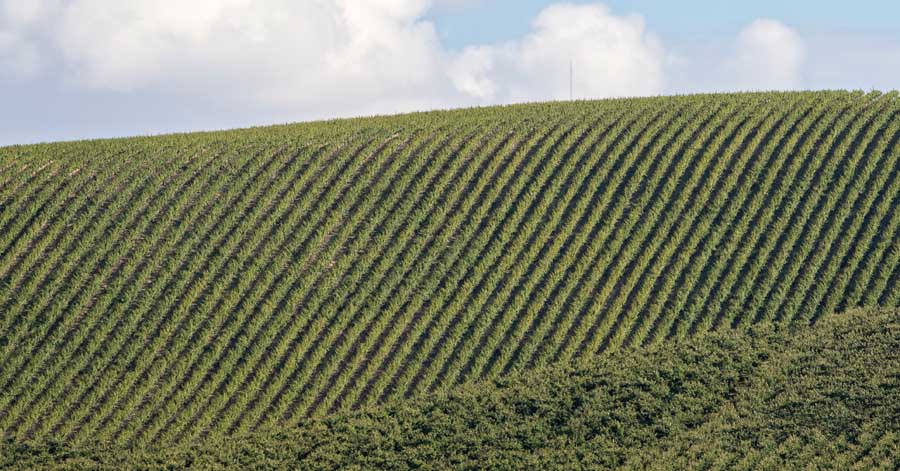
Grape vineyards near Sunnyside, Washington. (TJ Mullinax/Good Fruit Grower)
The impact of viticultural practices on the composition of wine flavor ranked first in a survey of Washington wine grape growers, vintners and researchers to prioritize research efforts and money and gauge awareness of research efforts.
The survey by the Washington State Wine Commission found that a majority of wine grape growers and winemakers are aware of the commission’s targeted research program, launched last fall.
The survey garnered a record number of responses, 138, representing 12 of the 14 appellations in the state and wineries and vineyards of all sizes.
Respondents ranked six categories of research on a five-point scale: fermentation management, aroma and flavor compounds in wine, impact of viticultural practices on fruit and wine quality, grapevine viruses, other diseases and pests, and site selection and site management.
The highest ranked topic was the impact of viticultural practices — heat and light exposure, crop load, irrigation and nutrition — on wine flavor, with a score of 4.5 out of five.
Tied for second in the survey were grapevine viruses and fermentation practices, including the impact of yeast strains, wine spoilage and nutrient status on wine flavor, both with a score of four out of five.
Overall, the scores for the six categories ranged from 3.3 to 4.5.
“The survey shows that the program is gaining traction and off to a strong start,” said Steve Warner, president of the Washington State Wine Commission.
Targeting research
The survey is intended to aid the Wine Research Advisory Committee, which is a subcommittee of the Wine Commission, with setting viticulture and enology research priorities. The current list of priorities covers a broad swath of industry topics, broken into several categories, including:
—Fementation management: includes phenolic measurement and management, sulfide avoidance and removal, botrytis and bunch rot management, process control and fermentation monitoring, among other things.
—Aroma and flavor compounds in wine: includes modification of grape derived flavor compounds, flavor active compounds derived from microbial metabolites, smoke taint analysis and removal.
—Impact of viticultural practices on composition and wine flavor: includes canopy management, improving water use efficiency, crop load estimation, berry shrivel.
—Diseases and pests: includes replanting, vector control, trunk canker diseases, powdery mildew and nematodes.
—Site selection and site management: predictive vineyard site models and predictive inversions models.
—Mechanization options for viticulture practices.
—Winery waste.
In the survey, respondents recommended nearly 200 topics for additional study; many touched on areas that have already been heavily researched.
While that shows the research program is on the right track, it also may indicate the need for more education efforts to ensure growers know about the research that’s already being done to benefit the industry, research program manager Melissa Hansen said.
Rick Hamman, viticulturist for Hogue Ranches and chair of the commission’s Research Advisory Committee, agreed.
“I was kind of pleased that they did have some overlap to our current research priorities; that really was good. We felt like we weren’t missing the boat too much and we’re covering things fairly well,” he said.
A couple of key themes came out in the recommendations. One, water management, was unsurprising given the drought conditions Northwest growers endured last year.
“We’ve done a lot of work on irrigation, and there’s still lots to be done, because every site is different and how you manage is different, and there are a lot of variables at play — sprayer type, variety.
There’s a lot of unanswered questions, and that’s why irrigation is a hot topic worldwide,” he said.
Survey respondents also expressed interest in research into new technologies, from the use of drones and new, high-tech optical sorters to mechanization of pruning and harvest.
“There’s been a lot of advancements in the field, but we want to keep close on this new technology and make sure we can help the research advance in that area,” he said. “Winery waste issues also seem to be a little more of a topic that needs to be addressed, and that’s something we did write down as part of an extra look.”
Those suggestions, along with all of the others, will be taken into consideration by the Wine Research Advisory Committee as it revises its research priorities this summer, Hamman said. •
– by Shannon Dininny






Leave A Comment